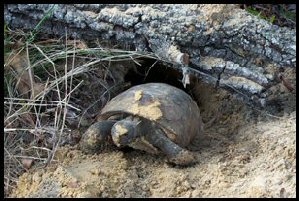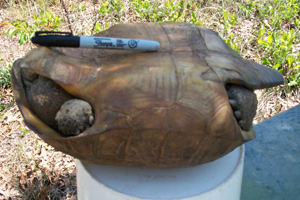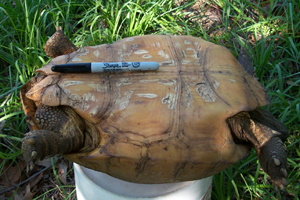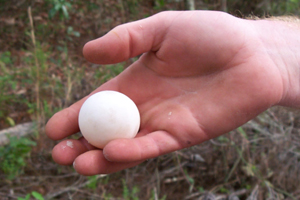YES… GOPHER
http://www.gophertortoise.org/tortoise/facts.htm
A couple of folks didn’t think I knew what I was talking about when I called it a Gopher. While I did realize that the furry animals are also called gophers, I did not realize that folks from other parts of the US did not know about the Gopher Tortoise; commonly called just a Gopher here.
I’m not a smart man… but I know what a gopher is.. ….

Gopher Tortoise Facts
The gopher tortoise (gopherus polyphemus) belongs to a group of land tortoises that originated in North America 60 million years ago, thus making it one of the oldest living species.

The gopher tortoises can be found throughout the state of Florida and southern areas of Georgia, South Carolina, Mississippi, Alabama and the tip of Eastern Louisiana. They dig their burrows in dry habitats. The gopher tortoise grows on average to be about slightly less than one foot long and weighs about 29 pounds, though they have been found to be as big as 16 inches.
The gopher tortoise is unique in that it is one of the few tortoises to actually make large burrows. Many tortoises hide under vegetations or use very shallow burrows.
The gopher tortoise is a turtle as all tortoises are turtles, but not all turtles are tortoises. Ray Ashton states in his literature for the GTCI, think of them as a cow with a shell. They graze on vegetation just like cows, and therefore, are important players in spreading seeds. Gopher tortoises also have chiseled looking front feet (flippers) and elephant like hind legs.
The gopher tortoise is a rather plain looking turtle as far as colors go. They are either a dark tan, or gray. Their front legs are broad and flat, almost like a shovel. Their back legs look just like an elephant’s legs. The top part of their shell is fairly flat, The adult gopher tortoise is a rather drab looking animal, which is in stark contrast for the brightly colored hatchlings.
The gopher tortoise reaches sexual maturity between 12 and 15 years of age, when their shells are about 9 inches long.

Male

Female
When determining the sex of a tortoise, the most noticeable difference is that the
male’s plastron is concave (above left), whereas, the female’s is perfectly flat (above right).
The gopher tortoise has an elaborate courtship that begins in the spring. They will nest between April and July. Typically, the nests are dug very close to their burrow openings, where a clutch of 4-7 eggs are laid. After about 80 – 90 days, the young hatch and will often spend the first winter in their mother’s burrow.
 The gopher tortoise egg’s are round and about the size of a ping pong ball, they incubate for about 80 – 90 days, The sex of the offspring is determined by the temperature of the sand or dirt where the nest is incubating, if the temperature is above 30° C (85° F), the tortoises hatchling will be females. Temperatures below 30° C produce males.
The gopher tortoise egg’s are round and about the size of a ping pong ball, they incubate for about 80 – 90 days, The sex of the offspring is determined by the temperature of the sand or dirt where the nest is incubating, if the temperature is above 30° C (85° F), the tortoises hatchling will be females. Temperatures below 30° C produce males.

Hatchlings are 1 – 2 inches long and grow about 3/4 inch a year, Adults range in length from about 10 – 15 or 16 inches and can weigh about 30 pounds. Gopher tortoises live upwards of 100 years (tortoise pictured on right is about 2 years old)
.The gopher tortoise is a very important part of the local ecology. As in any food web, if you start taking certain flora or fauna out of the equation, then you can adversely affect the survival of that ecosystem. The gopher tortoise is especially important because the burrows, which are dug by the tortoises, also provide homes for other animals, such as indigo snakes, gopher frogs, mice, foxes, skunks, opossums, rabbits, quail, armadillos, burrowing owls, snakes, lizards, frogs, toads and other invertebrates, gopher tortoise burrows are home to about 250 species of animals at one time or another. Some species share the burrows with the tortoises and others utilize abandoned burrows. Since the burrows are used by so many species, it does not take a rocket scientist to see that removing the tortoises from the local habitat would leave many animals without homes. True, some of these animals will be able to relocate, but there are a few species that are found only in these burrows.
The gopher tortoise digs and lives in burrows, The burrows are their homes. The burrow provides protection from predators and the elements, and also during extreme conditions on the surface such as drought, freezing weather, and fires. The burrows can vary in length and depth. These variables are usually determined by the level of the water table. Burrows can be as short as about 6 – 10 feet long, but they average around 30 feet with a record of approximately 50 ft. (Ashton 2001). Depths vary from around 3 – 20 feet deep. The burrows vary in shape, with most being straight or with only slight curves.
Gopher tortoises are primarily herbivores and feed on many species of low-growing plants. The largest part of their diet consists of grasses and legumes. They also eat gopher apple, pawpaw, blackberries, saw palmetto berries, and other fruits. Gopher tortoises will also scavenge and are opportunistic feeders, occasionally feeding on dead animals or excrement.
Gopher tortoises rarely drink (or are rarely seen drinking) from standing water. They can use their front flipper like legs to dam-up water as it runs down their burrow during a rain. Most of the water they get comes from the food they eat. During periods of extreme dro
ught they have been seen drinking standing water on the side of the road.
In Florida gopher tortoises are on the Endangered Species List, categorized as a Threatened Species. This means that their current numbers are dropping but we are not sure exactly how much, several studies presently being conducted on the tortoises are tiring to more accurately answer this question. Their primary reason for being endangered is a loss of habitat. In the past many tortoises were killed either for food, or by people who were trying to kill the rattlesnakes that often share their burrows.
We can all help gopher tortoises in the wild by preserving their upland habitats. Or, if you happen to see a tortoise, or turtle for that matter, trying to cross a road, please help them safely across the street without changing the direction in which they were traveling. Also, it is very important to never transport tortoises out of their habitat. It only takes one sick tortoise to infect an entire population of healthy tortoises.